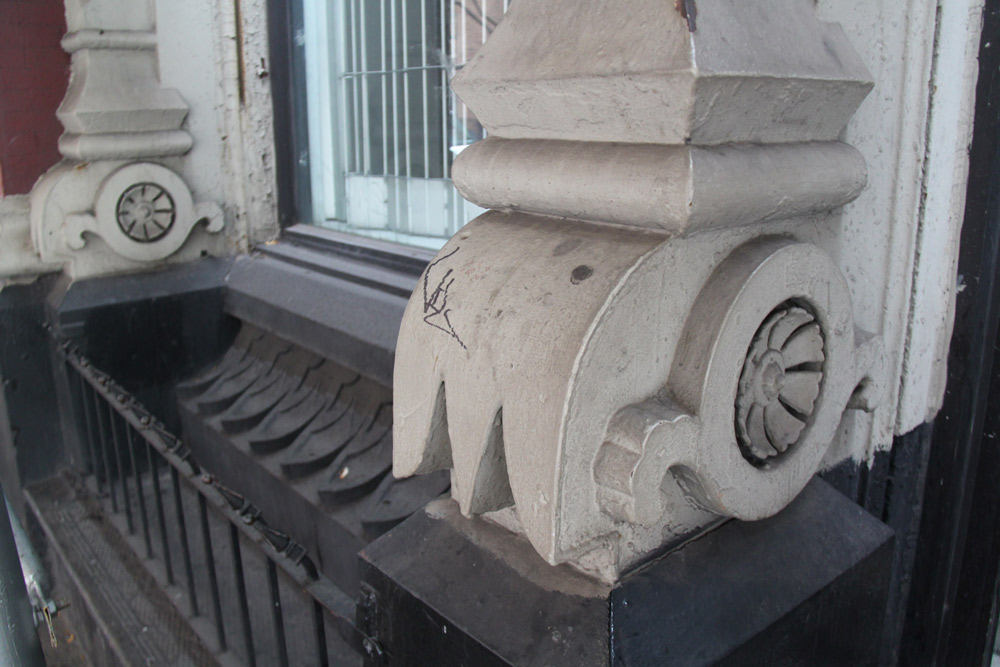Building (670) Broadway: Pilasters with…Bird Feet?
For today’s “Building Broadway” offering, I couldn’t help but notice a curious detail as I walked along the bustling thoroughfare: pilasters with bird feet bases at 670 Broadway! Well, that’s very likely not what they are, but I’ve never seen bases designed like that (but if you have, please share).
On the Monday before Thanksgiving, feast your eyes on five great things (with snippets of history thrown in) about this beauty of a building at the corner of Broadway and Bond Street in the NoHo Historic District. Hint: There’s a couple more bird references to be found!
Bird Feet Pilasters!
As I already mentioned, these are very likely not bird feet, but I can’t see anything else now — I guess I’m just ready for that Thanksgiving turkey. By the way, if you’re wondering, “pilaster” is another name for a square column.
Unfortunately, the ground floor is covered in scaffolding so this photo isn’t the best, but you can get a sense of these great cast iron Corinthian pilasters and how they frame the storefronts. Designed by George E. Harvey for Adele L.S. Stevens, this building dates to 1873-74 when cast iron construction was particularly popular in this area. According to the NoHo Historic District Designation Report, Michael Grosz and Son were responsible for the ironwork.
Did you happen to notice the feather-like detail in between the pilasters in the opening photo of this post?
A Sandstone and Red Brick Beauty
In my blog post on 1 Astor Place, I shared my love of red brick buildings. I don’t just mean your typical red brick; I’m talking about the deep red you see in the photo above, which was popular in the Victorian era. I love how it adds a bold punch of color on even the greyest of winter days.
On this building, the red brick also makes the grey sandstone trim pop. There’s a lot going on here, and I caused a lot of heads to turn and look up at the building as I was standing on the sidewalk admiring it all. Brick is used to create decorative spandrels and to emphasize the top and bottom of each brick pier. And the “double decker” cornice (not an official term!) sports brick corbelling that matches the spacing of the brackets above.
The sandstone trim features carved motifs of varying shapes. This Neo-Grec detailing is also found on many of our neighborhoods’ ‘Old Law’ tenements.
Tie Rods with a Message
Looking up at the building, I noticed these ornate iron tie plates. It’s a typical feature seen in older buildings used to help anchor the exterior wall to the interior floor plate. (You can see starfish-shaped ones down at the South Street Seaport, which playfully connect to the maritime heritage there.)
As I zoomed in to take photos of 670 Broadway’s tie plates I noticed something quite exciting: the date of the building revealed itself as I moved my eye across the facade! If a building date is incorporated into a facade’s design, you usually see it at the cornice — so this was a fun treat.
A Strong Corner
This building sits at the corner of Broadway and Bond Street, and both facades are equally impressive. The Corinthian colonettes could use a wash, but they still offer wonderful depth to the window bay.
The arched sandstone lintels feature pointed cutouts along the bottom edge, which kind of remind me of the upright tail of a turkey (while we’re on a Thanksgiving theme, right?).
Brooks Brothers, the men’s clothing company still in business today, was the building’s first tenants and stayed here until 1884. If you were a shopper at that time, you would have found their custom- and ready-to-wear clothing displayed and sold on the ground floor; military and custom clothes on the second floor (the floor highlighted in the photo above); and workshops and storerooms on the upper floors.
Shinbone Alley
What would a building steeped in manufacturing history be without a great “unfinished” elevation at the rear? Even better is the presence of an alley – in this case Shinbone Alley – to give you an unobstructed view. Clearly this elevation is a lot simpler than the street-facing facades, but the metal hinges that perhaps once supported metal fire shutters are subtle reminders of the building’s past.
The windows at the corner (and on the Bond Street-facing corner) have been bricked in at what appears to be a later date given the brick’s color and pattern. Also, if you’re wondering like I was, there are ornate iron tie plates on the Bond Street facade, but no numbers as on the Broadway side.
What do you think of this building? A beauty, right? The Landmarks Preservation Commission thought so too when they featured a historic image of this building on the front cover of the designation report, published in 1999.
Click here for the full reveal:









